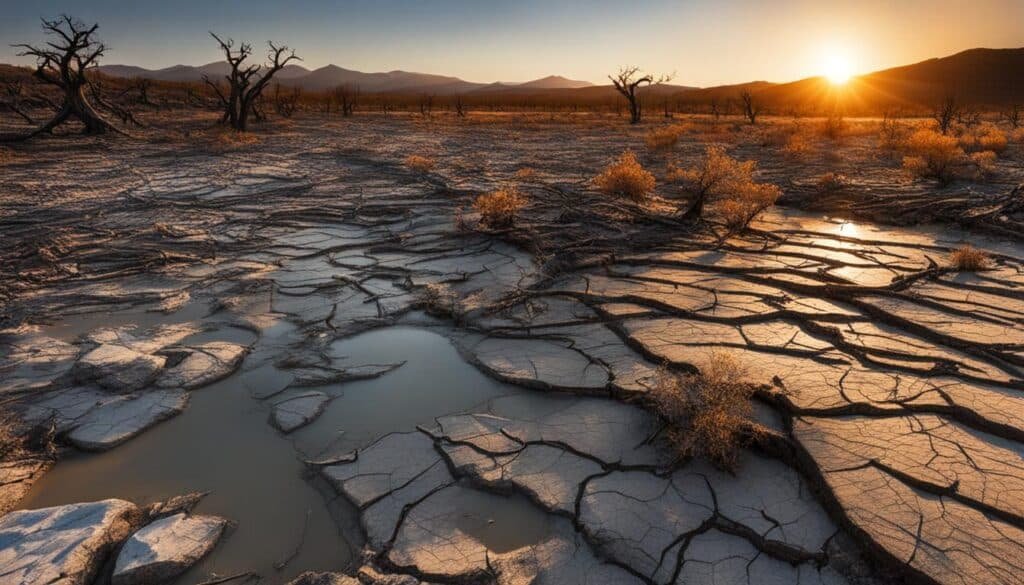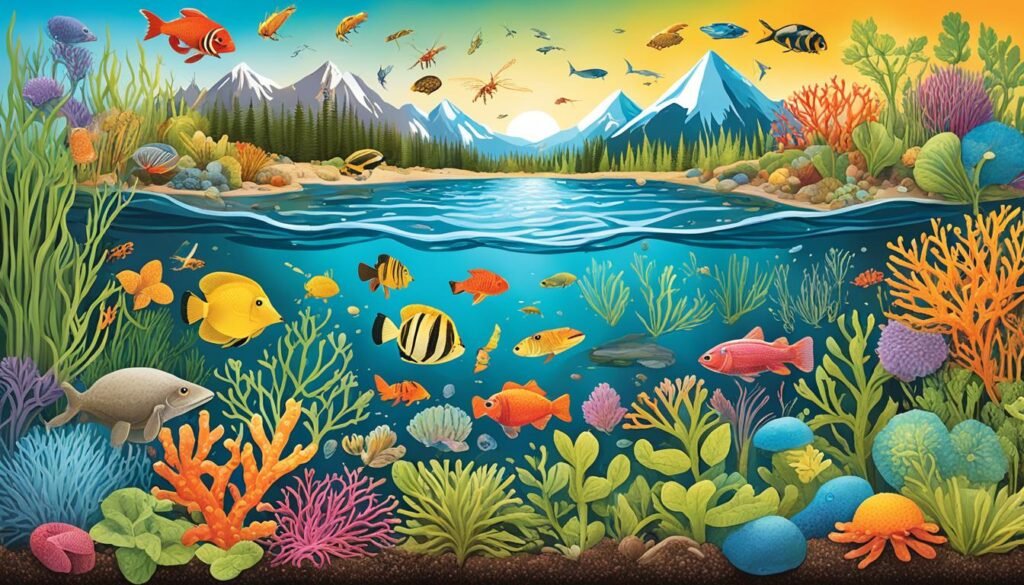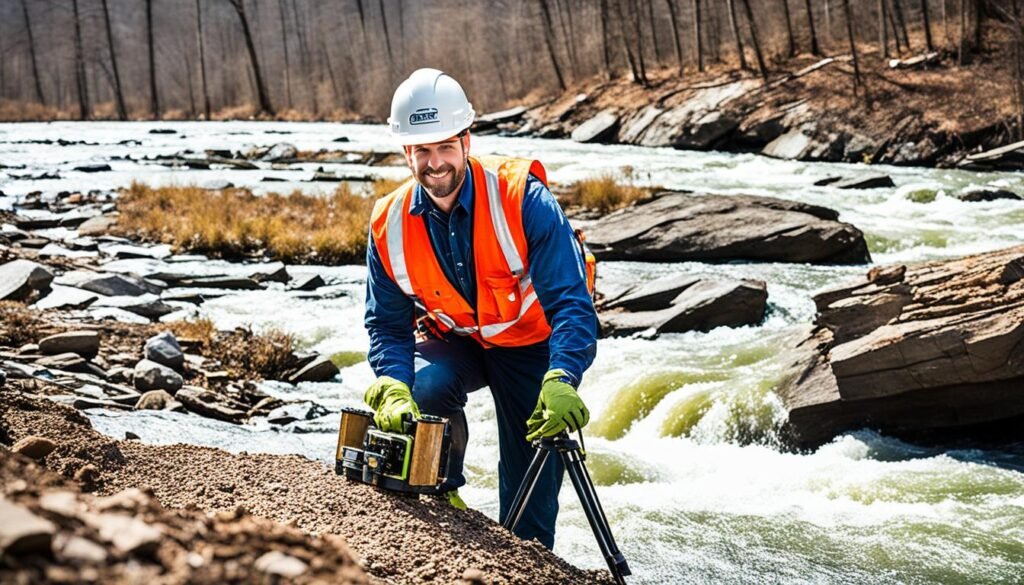Welcome to the captivating world of Earth Sciences! In this article, we will embark on a journey of discovery, delving into the mysteries of Earth’s climate, geology, and the intricate processes that make our planet dynamic and awe-inspiring. From the breathtaking landscapes to the diverse ecosystems, Earth Sciences encompasses the study of every facet of our magnificent planet.
Through the lens of Earth Sciences, we gain a deeper understanding of the forces that shape our environment, the intricate balance of Earth’s systems, and the importance of preserving and protecting our world for future generations. So, let us dive in and uncover the wonders hidden within our Earth!
Key Takeaways:
- Earth Sciences explore the climate, geology, and processes that shape our planet.
- Earth Sciences provide a comprehensive understanding of the dynamic nature of Earth.
- Ecosystems play a crucial role in Earth Sciences, emphasizing the interconnectivity of life.
- Through Earth Sciences, we can study natural hazards and mitigate their impact.
- Exciting career opportunities exist in various sectors within Earth Sciences.
The Science of Earth: Earth Sciences Defined
Before we dive deeper, let’s define what Earth Sciences entail. Earth Sciences, also known as environmental sciences, is a multidisciplinary field that encompasses the study of the Earth’s physical properties, composition, processes, and the interconnectivity of its various systems. It includes branches such as atmospheric sciences, geology, oceanography, geochemistry, and more.
In Earth Sciences, scientists explore the diverse aspects of our planet, examining its geological formations, atmospheric conditions, and the intricate ecosystems that sustain life. By studying Earth Sciences, we gain insights into the complex interactions between the Earth’s systems and how they shape our environment.
What exactly are Earth Sciences?
Earth Sciences are a dynamic blend of scientific disciplines that aim to deepen our understanding of the Earth, its processes, and the environmental factors that influence it. This field of study is crucial for comprehending the planet’s natural phenomena, including climate change, geological activity, and the intricate web of life within its ecosystems.
The environmental division of Earth Sciences
One significant aspect of Earth Sciences is its environmental division, which focuses on the relationship between the Earth and its living organisms. Environmental Earth Sciences explore the impact of human activities on the planet, aiming to find sustainable solutions to mitigate these effects.
Within Earth Sciences, the environmental division includes the study of atmospheric sciences to understand weather patterns and climate change, geology to investigate the Earth’s composition and geological formations, oceanography to explore the world’s oceans, and geochemistry to examine chemical processes in the Earth’s systems.
By delving into Earth Sciences, scientists aid in predicting and managing natural hazards, preserving biodiversity, and promoting sustainable practices that protect the Earth’s resources. This multidisciplinary approach ensures a holistic understanding of our planet and empowers us to make informed decisions regarding its conservation.
Earth Sciences: Enriching Our Knowledge
Earth Sciences provide us with invaluable insights into the intricate workings of our planet. By unravelling the complexities of its physical properties, composition, and processes, we gain a deeper appreciation for the Earth’s wonders and develop strategies to safeguard its environment for future generations.
In the upcoming sections, we will explore different branches of Earth Sciences, including geology, climate science, atmospheric studies, oceanography, ecosystem dynamics, and natural hazards. Join us on this enlightening journey as we unravel the mysteries of our dynamic planet.
Uncovering the Earth’s Geological Secrets
Geology, a fundamental aspect of Earth Sciences, plays a crucial role in unraveling the mysteries of our planet’s solid earth and its geological history. By studying rocks, minerals, and the processes that have shaped them, geologists gain insights into Earth’s evolution over billions of years.
One of the fascinating aspects of geology is the study of different types of rocks. Through careful analysis, geologists are able to determine the composition, structure, and origins of these rocks, providing valuable information about past geological conditions and events. By examining the layers of sedimentary rocks, for example, geologists can uncover evidence of ancient ecosystems, climate variations, and even the occurrence of catastrophic events such as volcanic eruptions and asteroid impacts.
Geological formations are another area of interest for geologists. These formations, such as mountain ranges, canyons, and caves, reveal the dynamic processes that have shaped the Earth’s surface. They are a testament to the immense forces at work, including tectonic plate movements, erosion, and deposition. By studying these formations, geologists gain a deeper understanding of how the Earth’s geological processes have shaped our planet.
One of the key components of geology is the study of bedrock. Bedrock, the solid rock that forms the foundation of the Earth’s crust, holds valuable clues about the geological history of the planet. By analyzing the composition and structure of bedrock, geologists can unravel the complex processes that have shaped our planet, including the movement of tectonic plates, the formation of mountains, and the creation of geological features like faults and folds.
Types of Rocks
Geologists classify rocks into three main types: igneous, sedimentary, and metamorphic. Each type provides unique insights into the Earth’s geological history.
| Type of Rock | Description |
|---|---|
| Igneous | Rocks that form from the cooling and solidification of molten magma or lava. They can provide information about volcanic activity and the composition of the Earth’s interior. |
| Sedimentary | Rocks that form from the accumulation and lithification of sediments. They can provide evidence of past environments, climate conditions, and the presence of fossils. |
| Metamorphic | Rocks that form from the transformation of pre-existing rocks due to intense heat and pressure. They can provide insights into the geological processes that occur deep within the Earth’s crust. |
By studying the different types of rocks, geologists can reconstruct the geological history of the Earth and gain a better understanding of the processes that have shaped our planet.
Understanding the Earth’s geology is not only a fascinating scientific pursuit but also essential for various practical applications. Geologists play a crucial role in resource exploration, environmental management, and hazard assessment, among other fields. Their knowledge and expertise contribute to a deeper understanding of our planet and help inform decisions that impact our lives and the environment.
The Science of Climate: Environmental Change and its Impact
Climate is a significant component of Earth Sciences, encompassing the study of weather patterns, long-term atmospheric conditions, and the impact of human activities on the environment. Understanding climate and its changes is crucial for tackling global environmental challenges and promoting sustainability in our approach to preserving our planet.
Climate change refers to the long-term alteration in Earth’s climate patterns, primarily due to increased greenhouse gas emissions. As a result, we are experiencing rising temperatures, changing precipitation patterns, and more frequent extreme weather events. The consequences of climate change are far-reaching, affecting ecosystems, livelihoods, and the overall well-being of both human and non-human species on Earth.
“Climate change is not just a scientific issue; it is an environmental, social, economic, and political concern that requires collective action.”
The interconnectivity of Earth’s systems plays a vital role in climate change. The Earth system encompasses the atmosphere, hydrosphere, biosphere, and geosphere, all of which interact and influence climate patterns. Changes in one component of the Earth system can have cascading effects on the entire system, further exacerbating environmental change.
To comprehend the impacts of climate change, scientists use a wide range of tools, including climate models, satellite observations, and historical climate data. These resources provide valuable insights into the past, current, and projected future climate scenarios, aiding in ongoing research and informed decision-making.

The urgent need to address climate change requires global collaboration and collective efforts. It demands sustainable practices, reduced greenhouse gas emissions, and adaptation strategies to mitigate the adverse effects on our planet and future generations. By prioritizing environmental change mitigation and sustainable practices, we can strive towards a more resilient and harmonious coexistence with Earth’s ever-changing climate.
Unveiling Earth’s Atmospheric Mysteries
Earth’s atmosphere is a complex and dynamic system that plays a crucial role in regulating our planet’s climate and weather patterns. In this section, we will delve into the fascinating realm of atmospheric science, exploring the various layers of the atmosphere, meteorology, cloud formation, and the intriguing phenomena that occur within our atmospheric domain.
Atmospheric science, also known as meteorology, is the branch of Earth Sciences that focuses on the study of the atmosphere, its composition, and the processes that shape it. By examining the atmospheric layers, including the troposphere, stratosphere, mesosphere, thermosphere, and exosphere, scientists gain valuable insights into the forces that drive weather patterns and climatic conditions.
“The atmosphere is a mysterious and ever-changing realm that holds the key to understanding Earth’s weather and climate.”
Cloud formation is a captivating atmospheric phenomenon that occurs when air rises, cools, and condenses around tiny particles, resulting in the formation of visible cloud structures. These clouds play a significant role in both the distribution of heat and the hydrological cycle. They not only provide us with mesmerizing sights but also influence weather patterns and contribute to the overall climate of different regions.
Throughout history, humans have observed and documented various atmospheric phenomena, such as hurricanes, tornadoes, and lightning. These events continue to captivate our curiosity and have a significant impact on our daily lives. By studying these phenomena, meteorologists gain insights into the complex interplay between atmospheric conditions, wind patterns, and moisture content, enabling them to enhance weather forecasting and improve our ability to respond to natural disasters.
Advancements in technology, particularly the use of satellites and science data, have revolutionized our understanding of atmospheric processes. Satellites provide valuable imagery and measurements of different atmospheric parameters, such as temperature, humidity, and cloud cover, allowing scientists to monitor changes and patterns over vast areas. This data enables us to track severe weather conditions, monitor air quality, and study long-term climate trends.
The Role of Satellites in Atmospheric Research
Satellites serve as essential tools in meteorological research by providing a comprehensive view of the Earth’s atmosphere. They allow scientists to observe and analyze atmospheric conditions on a global scale, facilitating the study of weather systems, climate change, and the interplay between the atmosphere and other Earth systems.
Science data obtained from satellites not only aids in weather prediction and climate modeling but also contributes to the understanding of atmospheric chemistry, ozone depletion, and the impacts of air pollution. This knowledge is vital for developing strategies to mitigate the effects of human activities on the atmosphere and to preserve the health of our planet for future generations.

Discovering Earth’s Dynamic Oceans
The Earth’s oceans, covering approximately 70% of the planet’s surface, play a crucial role in shaping our climate, sustaining diverse ecosystems, and driving geological processes. Delving into the field of oceanography allows us to unravel the mysteries of these vast marine environments and understand their profound influence on our planet.
Oceanography is an interdisciplinary science that explores the physical, chemical, biological, and geological aspects of the world’s oceans. By studying oceanography, we gain valuable insights into ocean currents, marine life, and the interplay between the ocean and other Earth systems, such as the atmosphere and land.
The marine environments found within the Earth’s oceans are incredibly diverse, ranging from the sunlit surface waters to the deep, dark abyssal plains. These environments host a multitude of fascinating organisms, many of which are still undiscovered and possess unique adaptations to thrive in their specific habitats.
One of the key areas of study in oceanography is hydrology, which focuses on the movement, distribution, and properties of ocean waters. Understanding ocean currents, tides, and waves helps us comprehend the intricate dynamics of oceanic systems, which influence weather patterns, nutrient distribution, and the transport of heat across the globe.

“The ocean stirs the heart, inspires the imagination, and brings eternal joy to the soul.” – Robert Wyland
Moreover, the geological processes occurring within the oceans shape not only the seabed but also the continents themselves. Oceanic currents and plate tectonics contribute to the formation of seafloor features like trenches, ridges, and volcanoes, while also playing a role in the recycling of minerals and nutrients essential for life on Earth.
Through ongoing research and exploration, oceanographers continue to expand our understanding of the complex interactions within marine ecosystems and their significance in maintaining the delicate balance of our planet. By uncovering the secrets held by the Earth’s dynamic oceans, we gain valuable knowledge that can inform conservation efforts, climate models, and sustainable management of our precious marine resources.
The Role of Oceanography in Environmental Conservation
Oceanography plays a vital role in environmental conservation by providing critical information for marine protected area design and management. By studying marine ecosystems and their response to changing environmental conditions, oceanographers contribute to the conservation and preservation of biodiversity in our oceans.
Additionally, oceanographic research helps us understand the impacts of human activities such as pollution, overfishing, and climate change on ocean health. Armed with this knowledge, we can develop strategies to mitigate these threats and work towards a more sustainable future for our oceans and the life they support.
| Marine Environments | Main Features |
|---|---|
| Coastal Zone | – Shallow waters – Rich biodiversity – Interaction with land and human activities |
| Open Ocean | – Vast expanses of deep water – Low nutrient concentrations – Home to migratory species |
| Abyssal Plains | – Deepest regions of the ocean – Dark and cold – Support unique organisms |
| Tidal Zones | – Intertidal regions affected by tides – Dynamic ecosystems – Exposure to air and water |
Exploring Earth’s Ecosystems: The Interconnectivity of Life
Earth Sciences encompass the study of ecosystems, which explores the interrelationships between living organisms and their environment. It delves into the intricate web of life on Earth, from the smallest microorganisms to complex ecosystems, highlighting the importance of biodiversity for the health and sustainability of our planet.
The Earth’s ecosystems are a delicate balance of biological communities and their physical surroundings. They consist of various species, each playing a unique role in maintaining the overall stability and functioning of the ecosystem. Through careful observation and research, scientists gain valuable insights into the interactions between species, their habitats, and the processes that shape the environment.
The study of ecosystems, also known as biology or ecology, is crucial for understanding the interconnectedness of life on Earth. It provides essential knowledge about the intricate relationships between organisms, their adaptations to the environment, and the impact of human activities on these delicate systems.
The Importance of Ecosystems
Ecosystems are essential for the survival of species, including humans, as they provide vital services such as clean air, fresh water, food, and natural resources. They also contribute to climate regulation, pollination, waste decomposition, and overall environmental resilience.
Ecosystems come in various forms, including forests, grasslands, wetlands, coral reefs, and even urban environments. Each ecosystem has its own unique set of species and dynamics that contribute to the overall biodiversity of our planet. By studying ecosystems, scientists gain critical insights into how different organisms coexist, adapt, and rely on each other for survival.
Human Impact on Ecosystems
Unfortunately, human activities have significantly impacted ecosystems worldwide. Deforestation, pollution, habitat destruction, and climate change are just a few examples of how human actions have disrupted the delicate balance of ecosystems. These disruptions can lead to the loss of biodiversity, the decline of species populations, and the degradation of critical habitats.

Protecting and Restoring Ecosystems
Recognizing the importance of ecosystems, efforts are being made to protect and restore these delicate environments. Conservation initiatives, sustainable land-use practices, and the implementation of environmental policies aim to preserve biodiversity and promote the sustainable use of natural resources.
The Role of Science and Research
Scientific research plays a vital role in understanding ecosystems, identifying environmental challenges, and developing innovative solutions to conserve and restore these vital systems. By studying ecosystems, scientists can provide valuable insights into the complex interplay between species, the environment, and human activities.
Case Study: The Great Barrier Reef
| Threats | Impact |
|---|---|
| Coral Bleaching | Loss of coral cover, decrease in biodiversity, and habitat degradation |
| Pollution | Water quality deterioration, eutrophication, and coral disease outbreaks |
| Overfishing | Disruption of food chains, loss of key species, and ecosystem imbalance |
| Climate Change | Rising sea temperatures, ocean acidification, and increased frequency of severe weather events |
The Great Barrier Reef, one of the world’s most diverse ecosystems, faces numerous threats due to human activities and climate change. Coral bleaching, pollution, overfishing, and rising sea temperatures pose significant challenges to its health and sustainability. Efforts are being made to address these threats and protect this ecological wonder through research, conservation programs, and sustainable tourism practices.
By studying ecosystems and taking action to protect and restore them, we can ensure the continued existence of diverse species, maintain environmental balance, and safeguard the well-being of our planet for future generations.
Understanding Natural Hazards: Earth’s Potential Dangers
Earth Sciences provide valuable insights into the understanding and prediction of natural hazards that pose threats to life and property. By studying the geological processes behind these hazards, scientists and experts are able to assess and mitigate risks associated with events such as earthquakes, volcanic eruptions, landslides, and more.
Advancements in technology play a crucial role in improving our ability to predict and respond to natural hazards. Through the use of advanced monitoring systems, satellite imagery, and data analysis, scientists can gather real-time information about potential hazards and issue warnings to affected areas.
One of the most widely recognized natural hazards is earthquakes. These geological events occur when the Earth’s tectonic plates shift, resulting in the release of energy that causes the ground to shake. Understanding the causes and characteristics of earthquakes is essential for developing effective strategies to minimize their impact and protect communities.
Earthquakes: Assessing Risks and Building Resilience
Earthquakes are measured using the Richter scale, which quantifies the intensity of the seismic waves produced. By analyzing historical earthquake data and studying fault lines, scientists can assess the potential risks and vulnerability of regions to future earthquakes.
According to the United States Geological Survey (USGS), an earthquake’s severity is classified as minor (magnitude less than 4.0), light (4.0-4.9), moderate (5.0-5.9), strong (6.0-6.9), major (7.0-7.9), or great (8.0 or higher).
In areas prone to seismic activity, building codes and construction practices play a crucial role in minimizing the impact of earthquakes. Structural design considerations that account for the forces generated during an earthquake can help prevent structural collapse and reduce the risk of casualties.
Volcanic eruptions are another geological hazard that Earth Sciences help us understand. Volcanoes are formed when molten rock, ash, and gases are expelled from a vent on the Earth’s surface. By monitoring volcanic activity, scientists can issue early warnings and evacuation orders to protect nearby communities.
Volcanic Eruptions: Monitoring and Safeguarding Communities
Volcanic eruptions can release ash clouds, pyroclastic flows, and lava, posing risks to both human life and infrastructure. Monitoring systems such as seismometers, gas analyzers, and thermal cameras enable scientists to detect changes in volcanic activity and provide critical information for volcanic hazard assessment.
“Volcanoes can have a significant impact on the environment, climate, and human health. Understanding their behavior is crucial for the safety and well-being of at-risk populations,” explains Dr. Sarah Johnson, a leading volcanologist.
By understanding the geological processes involved in volcanic eruptions, scientists can help communities prepare for potential hazards by establishing evacuation plans, designing hazard-resistant infrastructure, and conducting hazard awareness campaigns.
Overall, Earth Sciences provide vital knowledge for assessing, predicting, and mitigating the risks associated with natural hazards. Through ongoing research and technological advancements, we continue to enhance our understanding of Earth’s potential dangers and work towards creating a safer, more resilient world.
Earth Sciences in Practice: Career Opportunities and Applications
The field of Earth Sciences offers a multitude of career opportunities across various sectors, providing a rewarding and dynamic path for professionals passionate about understanding and exploring our planet. Whether you aspire to be a scientist, researcher, investigator, or engineer, the possibilities within Earth Sciences are vast and exciting.
Academia presents an avenue for those inclined towards research and teaching, where scientists can contribute to the advancement of knowledge and nurture the next generation of Earth scientists. Universities and research institutions offer positions as professors, lecturers, or research fellows, providing not only the opportunity to conduct groundbreaking research but also to mentor aspiring scientists.
Research constitutes the backbone of Earth Sciences, and organizations such as geological surveys, environmental consulting firms, and government agencies provide platforms for scientists to delve into critical issues affecting our planet. From studying climate change and its impacts to investigating geological processes and natural hazards, such research contributes to a deeper understanding of Earth and helps us develop strategies for a sustainable future.
“The importance of ongoing research and investigation in Earth Sciences cannot be overstated. It is through relentless scientific inquiry that we unlock the secrets of our planet and make significant strides towards mitigating environmental challenges,” emphasizes Dr. Jane Carter, a renowned Earth scientist.
“Publishing scientific findings and sharing knowledge is a vital aspect of Earth Sciences. It not only allows scientists to disseminate their research but also fosters collaboration and drives further exploration within the field,” adds Dr. Carter.
In addition to traditional scientific research, Earth Sciences find applications in various industries and sectors. Geological engineers play a crucial role in assessing and mitigating geological hazards, ensuring the safety of infrastructure and communities. They apply their expertise to design and construct protective measures against landslides, earthquakes, and other geological phenomena.
Environmental management is another area where Earth Sciences contribute significantly. Professionals in this field work towards developing sustainable practices and policies that promote the conservation of natural resources, protect ecosystems, and minimize environmental impacts.
“Earth Sciences allow us to understand the intricate workings of our planet and develop innovative solutions to the environmental challenges we face. Careers in this field are not only intellectually stimulating but also offer the opportunity to make a meaningful contribution towards a better future,” says Dr. Michael Patel, a prominent geological engineer.
To thrive in the field of Earth Sciences, individuals must possess a strong analytical mindset, critical thinking abilities, and a passion for exploration. Adaptability, teamwork, and excellent communication skills are also essential for effectively collaborating with fellow scientists, stakeholders, and the wider community.
Brief Overview of Career Opportunities in Earth Sciences:
- Academia:
- Professor
- Lecturer
- Research Fellow
- Research:
- Scientific Researcher
- Research Associate
- Environmental Consultant
- Government and Regulatory Agencies:
- Geologist
- Seismologist
- Environmental Manager
- Engineering:
- Geological Engineer
- Environmental Engineer
- Geotechnical Engineer
The career opportunities within Earth Sciences continue to evolve as new technologies, research findings, and environmental challenges arise. As the world seeks sustainable solutions and a deeper understanding of our planet, professionals in Earth Sciences play a vital role in shaping our future and preserving the wonders of Earth for generations to come.
Also Read:- Technical Advisor Expertise for Your Projects

Conclusion
Earth Sciences, encompassing the study of the Earth’s climate, geology, and intricate processes, provide us with a deep understanding of our dynamic planet and its interconnected systems. Through our exploration of Earth Sciences, we gain valuable insight into the wonders of our planet and the importance of protecting and sustaining it for future generations.
By studying Earth Sciences, we unravel the complex mechanisms that drive climate patterns, uncover the secrets of the Earth’s geological history, and gain a deeper appreciation for the processes that have shaped our planet over billions of years. This understanding allows us to make informed decisions towards mitigating the impact of climate change and preserving our fragile ecosystems.
Earth Sciences also play a crucial role in assessing and predicting natural hazards such as earthquakes, volcanic eruptions, and landslides. Armed with this knowledge, we can develop strategies to reduce risk and improve our ability to respond effectively to these events, ultimately safeguarding lives and property.
Furthermore, Earth Sciences offer diverse career opportunities in fields such as academia, research, and environmental consulting. By pursuing a career in Earth Sciences, individuals can contribute to ongoing scientific investigations, develop innovative solutions, and help shape the future of our planet.
FAQs
What is Earth Sciences?
Earth Sciences, also known as environmental sciences, is a multidisciplinary field that encompasses the study of the Earth’s physical properties, composition, processes, and the interconnectivity of its various systems. It includes branches such as atmospheric sciences, geology, oceanography, geochemistry, and more.
What does geology study?
Geology is a fundamental aspect of Earth Sciences, focusing on the study of the Earth’s rocks, minerals, and the processes that have shaped its geological history. Geologists investigate the different types of rocks, geological formations, and analyze the Earth’s bedrock to understand the planet’s evolution over billions of years.
What is the study of climate?
Climate is a significant component of Earth Sciences, encompassing the study of weather patterns, long-term atmospheric conditions, and the impact of human activities on the environment. Earth scientists analyze climate change, global environmental challenges, and advocate for sustainability in preserving our planet.
What do atmospheric scientists study?
Atmospheric scientists explore Earth’s atmosphere, which plays a vital role in regulating climate and weather patterns. They investigate the various atmospheric layers, meteorology, cloud formation, and the intricate phenomenon that occur within our atmosphere. Satellites and science data contribute to understanding atmospheric processes.
What is oceanography?
Oceanography is the study of the Earth’s oceans, covering about 70% of the planet’s surface. Oceanographers examine the diverse marine environments, ocean currents, and the role of the oceans in shaping our planet’s geology. They investigate the interplay between the ocean, climate, ecosystems, and geological processes.
What is the study of ecosystems?
Earth Sciences encompass the study of ecosystems, focusing on the interrelationships between living organisms and their environment. Earth scientists explore the intricate web of life on Earth, from the smallest microorganisms to complex ecosystems. Biodiversity is crucial for the health and sustainability of our planet.
How do Earth scientists assess natural hazards?
Earth scientists study and predict natural hazards that pose threats to life and property. They assess risks associated with earthquakes, volcanic eruptions, landslides, and other geological events. Advancements in technology have improved our ability to predict and respond to such hazards, ensuring the safety and resilience of communities.
What are the career opportunities in Earth Sciences?
Earth Sciences offer a wide range of exciting career opportunities in academia, research, environmental consulting, and government agencies. Scientists, researchers, and investigators contribute to ongoing studies and publications. There are also applications in fields like geological engineering, environmental management, and sustainability.
What do Earth Sciences teach us about our planet?
Earth Sciences provide us with a comprehensive understanding of our planet’s climate, geology, and the intricate processes that shape Earth’s systems. By delving into the realms of Earth Sciences, we uncover the wonders of our dynamic planet and gain insight into how we can protect and sustain it for future generations.

